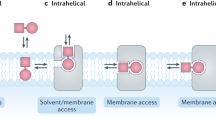Abstract
A panel of 25 different lipid agents was evaluated for in vitro activity against HT29 human colon carcinoma and HL60 promyelocytic leukaemia cells by 3-(4,5-dimethylthiazol-2-yl)-2,5-diphenyltetrazolium bromide (MTT) assay. The structure-activity relationships seen with this series, including those for four sets of positional or stereoisomers, indicate that specific receptor proteins are unlikely as targets for anti-tumour lipid (ATL) action. Additional data confirm the lack of involvement of the platelet-activating factor receptor in particular and suggest that metabolic stability is a most important determinant of ATL activity. More detailed studies, with 1-O-octadecyl-2-O-methyl-rac-glycero-3-phosphocholine (ET18-OCH3) and (+/-)-2-(Hydroxy[tetrahydro-2-(octadecyloxy)methylfuran-2- yl]methoxyphosphinyloxy)-N,N,N,-trimethylethaniminium hydroxide (SRI 62-834), suggest three different modes of activity, depending on drug concentration and exposure time. Low doses of up to 5 microM in standard serum-containing medium cause population growth arrest after prolonged exposure. Growth arrest was associated with a leaky G2/M block as determined by flow cytometry. These effects are reversible. Intermediate concentrations (5-40 microM) were cytotoxic, causing a net reduction in cell numbers after 2-3 days. At even higher concentrations, all lipids caused rapid, direct membrane lysis. When the clonogenic assay was used to assess the effects of ATLs, most agents reduced colony formation at concentrations above 5 microM. However, some compounds proved stimulatory at nanomolar concentrations, suggesting that they might possess mitogenic properties. These results, particularly those concerning the concentration and time dependence, may be relevant to current clinical trials with ether lipids.
This is a preview of subscription content, access via your institution
Access options
Subscribe to this journal
Receive 24 print issues and online access
$259.00 per year
only $10.79 per issue
Buy this article
- Purchase on Springer Link
- Instant access to full article PDF
Prices may be subject to local taxes which are calculated during checkout
Similar content being viewed by others
Author information
Authors and Affiliations
Rights and permissions
About this article
Cite this article
Lohmeyer, M., Workman, P. Growth arrest vs direct cytotoxicity and the importance of molecular structure for the in vitro anti-tumour activity of ether lipids. Br J Cancer 72, 277–286 (1995). https://doi.org/10.1038/bjc.1995.325
Issue Date:
DOI: https://doi.org/10.1038/bjc.1995.325
This article is cited by
-
Synthesis and Evaluation of Antitumor Alkylphospholipid Prodrugs
Pharmaceutical Research (2020)
-
Growth inhibitory effects of liposome‐associated 1‐O‐octadecyl‐2‐O‐methyl‐sn‐glycero‐3‐phosphocholine
Lipids (1997)



